|
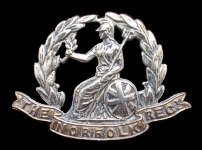
5573230
Lance Corporal
Charles James Hargrave
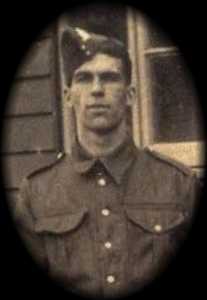
1917/07/31 - Born, Dinton, Wiltshire
Son of Ellen
Occupation Motor Engineer
1940/03/15 - Enlisted
Royal Norfolk Regiment
4th Battalion
Service
The 4th Battalion was under the command of Lt-Col. J.H.Jewson, M.C., T.D., who had his H.Q. at the Drill Hall, Chapel Field, Norwich. Second in command was Maj. A.E.Knights, M.C., M.M.
H.Q. Company was at Norwich, “A” and “D” Companies were at Yarmouth, “B” Company was at Attleborough and “C” Company at Harleston. The strength of the 4th was 29 officers, 39 warrant officers and sergeants and 607 other ranks, making a total of 675 men.
If anyone recognises a soldier please contact FEPOW Family
In October 1939, at the start of WW2, the Battalion was brought together at Gorleston, the H.Q had taken over the Holiday Camp situated at Bridge Road with “A” and “B” companies. “D” Company were at York Road Drill Hall, and “C” Company was at Great Yarmouth Race Course. Training began in earnest when N.C.O´s and other ranks were drafted from the 2nd Battalion.
During May with Britain at a low point after Dunkirk, and the threat of a German invasion, the 4th Battalion were given coastal duties. Beaches were mined and road blocks were manned by them. The 54 Infantry Brigade had the job of defending the beach from Cromer to Lowestoft, with the 4th Battalion covering Gorleston and Yarmouth. In June 1940 the Battalion was taken to 29 officers and 950 other ranks by drafts from the I.T.C., Royal Norfolk Regiment, at Billericay and the I.T.C., Wiltshire Regiment. This month also saw the first air raids with several bombs being dropped in the battalion’s area. During August the King visited Battalion H.Q. and inspected the Officers and men at Gorleston Holiday Camp.
On September 18th the battalion was moved to Langley Park Loddon and within days were put into Action Stations as an invasion was thought to be under way. After twelve hours of being on alert the men were stood down and training continued.
The 18th Division received its orders to finish its training in Egypt just before Christmas 1940, but before this Stobs Camp near Hawick, Scotland was to be its last training ground on British soil. Accompanied by the 4th Suffolks they arrived on January 8th 1941, in very cold conditions. The men wished they were back in the flat lands of Norfolk as the marches became longer but they were getting fitter.
By April the plan for Egypt was shelved and the 18th Division was moved to Blackburn under the command of Maj-Gen M.B.Beckwith-Smith. Here the training continued but with more stress on exercises, this ended with a two day endurance test in June. The Division came through this with flying colours and were now seen to be near ready. Before being posted abroad final route marches were to be carried out in Ross-on-Wye. So back to Scotland on August 13th went the Division. The men knew things were hotting up as their exercises now included river crossing and day and night landings from craft.
On September 9th, Lt-Col Jewson was promoted and Lt-Col. Knights was given the command of the battalion. With the Kings visit the men were seen to be now ready for action. Tropical kit was issued and orders were to proceed to Liverpool.
Andes
The 4th Battalion was then made ready to embark on the Andes, destination unknown.
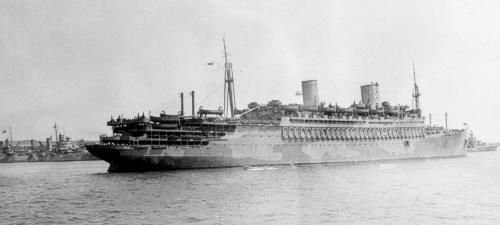
USS Wakefield
Arriving at Halifax 8th November the men were then moved across to the transport ship tied along side, the 27,000 ton Wakefield.
On November 10th the voyage continued with six American troopships, two cruisers, eight destroyers and the aircraft carrier Ranger, the Convoy William Sail 12X was under way, destination still unknown.
The convoy passed through the Mona Passage between Puerto Rico and St Domingo, arriving at Trinidad on 17th November in glorious sunshine so our tropical kit came out, but unfortunately no shore-leave, we left after two days of taking on supplies. On 24th we crossed the equator, there was a crossing the line ceremony.
After a month the convoy arrived at Cape Town, South Africa. By this time the Americans were in the war as the Japanese had bombed Pearl Harbour and attacked Malaya and the rumours were that they were heading for the Far East and not the Middle East as first thought.
On December 13th the convoy left Cape Town and sailed along the coast of East Africa past Madagascar and into the Indian Ocean heading for Bombay. After 17,011 miles at sea Bombay was reached December 27th 1941.
Embarked on 17th January back onto the Wakefield. The convoy sailed the next day with a British escort, the H.M.S. Exeter and H.M.S. Glasgow with British and Australian destroyers. Japan had entered the war by attacking Malaya on 8th December 1941, desination was the far East. The Prince of Wales and the Repulse had both been sunk by the Japanese off Malaya. Passing Colombo, (Ceylon), crossing the equator for the third time, the convoy passed through the Sundra Straits between Java and Samatra and then the Banka Straits. The convoy was then bombed by Jap Planes, there was no damage, the Wakefield was the first of our convoy to reach the safety of Keppel Harbour, Singapore on the 29th January 1942. Ships were ablaze in the harbour, clouds of smoke drifted across the sky and the smell of fumes was overpowering, this was not the best of greetings. The Japanese had taken most of Malaya in the last three weeks and were only thirty miles away from Singapore.
The 18th Division was moved to hold the north-eastern part of the island near the Changi Peninsula.
On the 5th February the Empress of Asia bringing military supplies, including ammunition for the 18th Division, was hit by bombs and went aground on the Sultan Shoal, this did not help the now desperate situation the battalion was in. The following days saw heavy bombing and bombardment from the Japanese. On Sunday the 8th February, using makeshift rafts, the Japanese 18th Division and 5th Division began the movement across the Straits separating Malaya and north-western end of Singapore. The Australian troops who faced them didn't get the artillery support they needed, and shielded by the dense smoke, the Japanese soon got a foothold, the fighting was soon hand to hand.
A” company and Capt. M.Gowing in the Teck Hock area. “B” Company with Maj. W.L.Faux was about two miles away, “C” company with Capt. T.C.Eaton in the Serangoon Jetty area and “D” company with Capt. S.F.Philips was in the Serangoon Church area. No contact was made with the enemy until the night of 7th-8th when the Japanese attacked the island of Ubin, off the Straits, to the right of the brigades sector. The enemy consisted of about 1,000 men and the small platoon guarding the beach had to make a quick withdrawal, four men failed to return.
The enemy were making ground quickly by infiltrated the allied lines and they were by the 9th February about two miles behind the defences. They then began to spread out putting the Peice and MacRitchie Reservoirs and the Seletar Aerodrome at risk.
On the 10th February “Tomforce” was formed, the battalion along with the Royal Northumberland Fusiliers formed this force under Lt-Col.L.C.Thomas. Their orders were to support 12 Indian Brigade and stop the enemy advance on Bukit Timah. The force travelled in buses to the north side of Bukit Timah then advanced towards the village, the 1/5 Sherwood Foresters advanced from the south, but that night the village was taken by the Japanese.
The next day the battalion advance through thick woods on a two company front. “A” were followed by “D” on the left and “B” followed by “C” on the right. The enemy were waiting and marked their position with flares, this was followed by low level bombing and machine-gunning. “B” and “C” companies were hit and suffered badly. It was considered an impossible task to advance further as the Japanese were heading north of “Tomforce” towards the reservoir near Thompson Village. The battalion withdrew to the Singapore Racecourse to try to stem the Japanese advance, joining with 4th Suffolks on the right to form a perimeter defence of the MacRitchie Reservoir.
All looked to be in place until an order for the 4th Suffolks to advance towards the Swiss Rifle Club Range, letting the Japanese infiltrate with cover fire from high ground they all ready held. This caused the right flank of the battalion to be exposed. The enemy quickly took the advantage and completely surrounded the battalion leaving only a small area free to the east.
At 9am on the 12th the Japanese attacked the forward line at “A” company in strength on the Bukit Timah road, using tanks they forced the company back. A counter attack was planned but orders to withdraw to Adam Road were received. They withdrew though the east gap but the carriers had to go down the Bukit Timah road and came across enemy tanks but against all the odds they managed to fight their way through without loss.
Once again under the command of the 54 Infantry Brigade, “Tomforce” was dissolved. Defences of the position in Adam Road were quickly put into place these included a barbed wire fence and that night some sleep was gained. The next day started with a heavy shell and mortar attack, allied artillery returned fire but there were many casualties during the day. That evening the battalion were relieved by 1/5 Sherwood Foresters, withdrawing to the east side of the road, however with the shelling very little rest was gained. The same pattern of shelling and bombing carried on into the 14th February causing heavy casualties, this later was followed by a prolonged attack to the north of the positions and with a second attack the Sherwood Foresters were forced back. “B” and “C” companies then counter attacked and regained their positions through heavy losses.
The situation on the island was now very critical with many troops over run and the enemy threatening to take control of the water supply. The end came very quickly, at noon on the 15th a car travelled down the Bukit Timah road with a white flag above a Union Jack, Singapore had capitulated.
Japanese PoW
PoW Card II 16804
Japanese Index Card - Side One
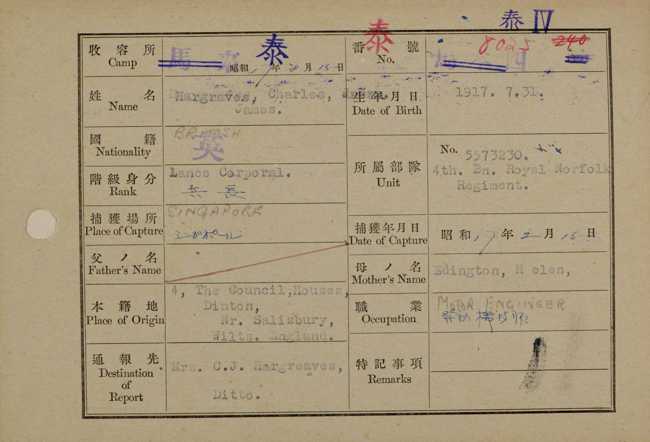
Japanese Index card - Side Two
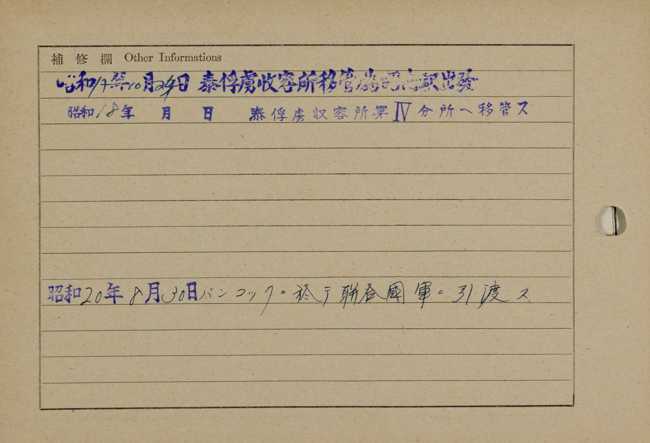
Charles PoW Camps
|
Date
|
Camp
|
Commander
|
|
1942/02/15
|
Changi
|
Col. Knights
|
|
1942/04
|
Bukit Timah
|
Col. Knights
|
|
1942/10/21
|
Transported to Thailand
|
|
|
|
New PoW No. II 240
|
|
|
1942/11
|
Tarsao, Thailand
|
Col. Knights
|
|
1943/03
|
Kanburu
|
Major Mills
|
|
1943/06
|
Wang Tan
|
Lt. Krail
|
|
1943/11
|
Chungkai
|
Lt. Krail
|
|
|
New PoW No. II 8025
|
|
|
1945/06
|
Ban Pong
|
|
|
1945/08/30 - Liberated Thailand
Repatriation
Flown from Bangkok to Rangoon before being shipped home.

1945/09/26 - Departed Rangoon in the SS Ormonde.

The Route home is shown on the post card.
Arrived Southampton, 22nd October.
|
Pacific Star
|
War Medal
|
1939-1945 Star
|
|
|
|
Died
1974 - Salisbury
1974/08/25 - Buried East Harnham
Information
Carol Bailes - Daughter
Royal Norfolks in the Far East
Thailand-Burma Railway
KEW:- WO 361/2172, WO 361/1979, WO 361/1954, WO 361/2196, WO 361/2177, WO 361/2060, WO 345/23, WO 392/24, WO 361/1987,
|